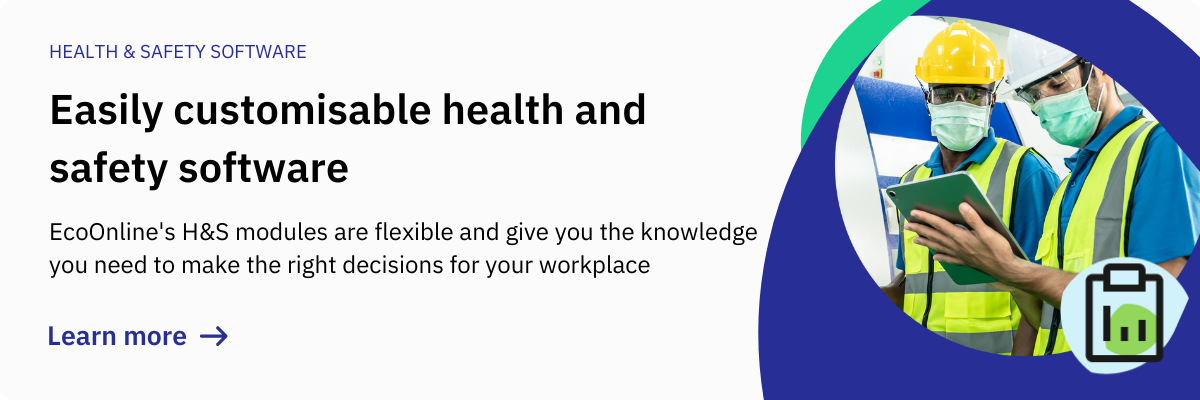EHS work can be time consuming, especially if you use a manual management method – such as spreadsheets or loose documents.
Health and safety software for large businesses is becoming more widely recognized as a necessity, but these tools are not reserved only for their use. Organizations of all sizes will benefit from an efficient health and safety software system to save time and ensure compliance with safety rules and regulations at work.
To ensure that your business follows the law and implements optimal routines for a safe workplace, you certainly rely on some sort of system in place. With software, you can rely on an easy-to-use system, available to the entire organization and customized to your needs. But, even if you have software, it may not have all the functionality you desire. So how do you know if the tool you use today is providing the best solution for you? We talked to our experts at EcoOnline, and we have some answers for you.
If you recognize one or more of the claims listed below, it is time to consider a new EHS system:
Sign 1: An accident has occurred, but you have no control over the course of events or the extent of the damage.
Do incidents come out of nowhere, and feel out of your control? Perhaps you also do not know if any deviations were reported that can be linked to the accident itself.
A hallmark of ineffective systems is feeling that they do not serve you any use at the times when you need them most. Effective EHS management tools – whether it be software or a manual system – should help you prevent accidents by noticing deviations from protocol in the first place.
Aisling Miller, Head of Product Training and Learning at EcoOnline, points out that “with data analytics on top of their forms, businesses can see "wow, when our slip/trip hazard report numbers go up, our slip/trip incidents with injuries go down, awesome". People are being given the time, space, and data to help them look at leading indicators and improvements rather than always looking at lagging indicators and transcribing data into Excel.” Then, when incidents do occur, you have a plethora of data to investigate and help you determine the root cause.
Sign 2: You spend a lot of time documenting EHS work and feel that you need a bigger team or more helping hands.
If it feels like you are always lagging in charting, planning and follow up measures, it could be time to consider having your organization make a change. Often, organizations will jump to the thought of hiring more employees.
Clear and consistent paperwork is an essential for any thriving business, but it should not take up the bulk of your time on the job. It should also not constitute a reason to bring on more staff. New software, instead, is a more viable solution to implement in managing all your important health and safety information.
Billy O’Brien, Director of Customer Success at EcoOnline, points out exactly how software can help. “You do not have to continually expand your number of employees to try and manage all the work associated with health and safety management, because it can be a very paper heavy process,” he said. “Some organizations are still paper based. That is very laborious, it is time consuming, and you will need additional resources. Whereas if you can automate as much as possible through a software solution, you are making it easier for people to gather the information and interrogate all that data.”
More automation means less time making calculations, ultimately giving you more time to do your job. Outdated models often do not have the automation capabilities of newer software options, meaning it may be time for your organization to start exploring.

Billy O'Brien, Director of Customer Success at EcoOnline
Sign 3: You use Excel or other manual systems for recording EHS tasks.
For some it may work to have EHS tasks documented in a manual system. But how can you be sure that all your documents are up to date? And what about employee availability – can everyone access this document? How do you ensure there are no errors in these documents? What if they differ from site to site, or even from each individual filing event?
Requirements for mapping risk assessment and preventive measures apply to both large and small companies. Without a system for recording EHS tasks, it can be difficult to follow the law. Of course, the law is of the utmost importance, and you always want to comply.
Moving to a newer, more streamlined, and easier to use system will ensure that you never fall out of compliance. You also do not want employees to grow frustrated with your EHS processes or dismiss them as too complex.
Helen Melby Brodersen, Head of PR Brand and Communication at EcoOnline, acknowledges that “the main challenge of managing the many EHS tasks is working in silos, making it difficult, if not impossible, to connect to other systems and data sources. It leaves many companies striving to gain the complete overview necessary to reduce risk to keep their employees and contractors safe at work.” She concurs that newer SaaS solutions, and their cloud-based nature, ensure that all employees have access to the information they need right when they need it. Using a unified platform decreases errors that result from poor communication, or a lack thereof.
Sign 4: If an inspector were to visit your organization today and requested access to your risk assessment, you would have doubts about your records being up to date and thorough enough to quell any of their concerns.
Maybe you are also not sure how to proceed with risk mapping. Maybe you haven’t been completing risk assessments as thoroughly as you should. Regardless of the specific concern you have, this is a problem. What do you really need to feel comfortable with visits from the Labour Inspectorate? If the answer is more time, or more personnel, the plain truth is that both will be hard to come by.
Instead, a switch to new EHS software could alleviate some of your problems. O’Brien points out that the real-time dashboards on newer EHS software are a pivotal tool for you to utilize when it comes to inspections. “Instead of having to take a template that is done in a Word document and re-enter the information into an Excel spreadsheet, then run a report at the end of each month or quarter, spending a week or two capturing data or inputting data to run a report for your senior management team, you’ll have that live information continually updated on a real time dashboard,” he explains. “And because it is real time, the information you're presenting is always up to date rather than being maybe two or three weeks out of date.”
When the step-by-step process of manual data interrogation is compared to the simplicity of an automated real-time dashboard, the better choice is clear. Enter inspections with confidence by making an upgrade.
Sign 5: Only you and/or the safety representative can report errors, omissions, accidents or nonconformities.
On an outdated system, you’ll find that certain employees only have specific capabilities. On newer platforms, any employee can report errors, near missions, accidents and more. Having to wait for one, designated individual to input information and generate reports is time consuming and often counterproductive.
To ensure the highest level of safety, you need the highest level of accessibility. O’Brien identifies this as a key aspect of newer EHS software models. He states that, “at a broad level, [EHS software is] being used now to get more engagement from employees. Any software solution now should be accessible by all employees. Information should be readily available for people to access.”
So, even if you can overcome the ‘clunkiness’ of older software, consider the access that a newer option could provide to employees across your organization and the ease with which this could get them involved in prioritizing workplace safety. New EHS software will help you do this, and it is even available on a mobile platform, so it is accessible anywhere, anytime.
Sign 6: Your current software is not helping your organization improve on health and safety metrics.
Perhaps you already have health and safety software in place, and you are aware of its shortcomings. Maybe you even recognize the ways in which it is holding your organization back. However, fear of change and the change management process is no reason to discount what a newer platform could offer your organization.
O’Brien notes that older systems tend to have their shortcomings and are often expensive to upgrade. Their capabilities are limited, too, with most “initially just tracking information, actions and maybe even just storing training records.” He said that newer, cloud-based forms of SaaS for EHS management streamline the process of updates and expand the possibilities for every organization using them.
Newer software has a stronger focus on data and trend tracking over time. Additionally, with the rapid pace of technological advancement, your employees likely expect a higher level of functioning from your organization. Especially if your technology is not helping you decrease injuries or other metrics, employees could begin to question your leadership.
O’Brien states that “Everybody now going into the workplace expects that the organization they are going into is using technology. Why can't we utilize systems in the workplace to help better inform employees about what is happening or where potential dangers are? Or updating them on how they are performing, in real time?”
The moment your employees begin to question the effectiveness of your health and safety software is the moment you lose their trust. Remember that employees are your most valuable stakeholders. Keep employees happy, save money and save time with an upgrade.
Do these points ring true for your organization? Don’t worry. You are not alone!
We know that work on systematic EHS is complex, which is why we have developed a solution that helps you meets all regulations, while also creating a safe workplace that promotes a sustainable safety culture.
EcoOnline’s EHS Management Software is a user-friendly, flexible tool that streamlines and simplifies the implementation, management and follow-up of all EHS tasks. You can select the modules that apply most to your company’s regulatory and health and safety context, configure them to operate in the way that works for you, and begin seeing results pour in.
Why choose EcoOnline EHS Management Software and Modules?
- Report, investigate and handle accidents – straight from your mobile device with all data backed up to a cloud-based system.
- Plan, conduct and follow-up on audits, inspections and safety rounds with streamlined and consistent templates.
- Make sure actions are taken by the right person at the right time by assigning and tracking with our module.
- Create your own customized risk assessments that easily and quickly meet your specific needs, and store that template for future use.
- Carry out EHS work in collaboration with employees, safety representatives and union representatives, so nobody is left out of the loop or uninformed.
Request your EcoOnline EHS Management Software demo today and discover why EcoOnline is the easiest choice for cultivating a safer workplace culture.
